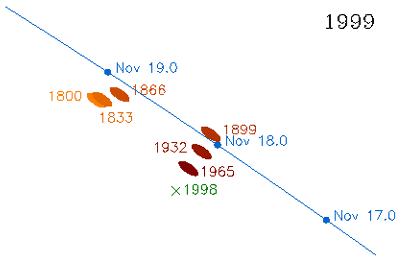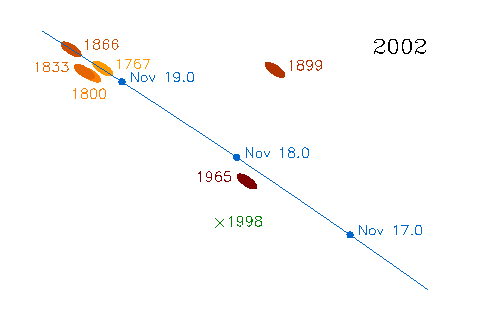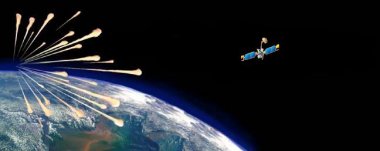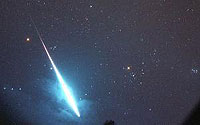The
Leonids this year should be seen particularly well in Northern
Africa and the Middle East. We in Algeria
are well situated to enjoy the firework. The shower should turn
indeed into a storm around 3:10am on Thursday 18 in the morning
with ZHR rate reaching 1000 to 1500 meteors an hour. The storm
shouldn't be as plentiful as the 1966 one with up to 40 meteors
a minute, but meteor storm is not an exact science and we could
be up to some surprises. We just have to recall the precocious
storm activity of the 1998 Leonids some 16 hours before the effective
crossing of the main dust trail! (More on that see
David Asher's explanations).
At
the left is a picture of a gorgeous 1999 explosive Leonid taken
by Arne Danielsen. |
.gif) |
|
More on the Trails
The encountering
with the main dust trail should last some one to two hours according
to computations and it should concern the 1899 comet Tempel-Tuttle trail.
We
see clearly in this plot by David Asher
the positions of the various dust trails left by the comet at each of
its passages near the Sun. The blue line corresponds to the Earth (enlarged
ten times) path in the ecliptic plane. The various elongated spots correspond
to the cross sections of the trails, the elongation being due to the
intersection angle between the Earth and the trail being non-zero. The
trails are color coded with the lighter ones being for the older thinner
ones. The green cross correspond to the last passage of the comet in
1998. For more explanations and plots and predictions for the previous
and next Leonids showers, see the
Armagh Observatory site.
We
are mobilized and we mobilize
A
public information campaign largely relayed in the media enabled our
Association to alert the Algerian public nationwide of this remarkable
astronomical event. The APS (The official Algerian Press Service) put
on its network the lengthy communiqué from our Association. Many newspapers
picked up the message, including Horizon (In its first page),
Al-Massa, An-Nasr, L'Authentique... Furthermore, members
of the association gave interviews on radio programs, with spots on
the event running throughout the week, a special news coverage on Cirta-FM,
and a topical event on the fortnight radio program (Nadi el-Maarifa) that
our Association is running.
In any case,
Sirius has mobilized all its members in the Constantine area, from el-Kroub,
to Sidi-Mabrouk, to Ain el-Bey, to Bab el-Kantara to be ready for the
fairy (and hopefully fiery) night.
Here
are some appropriate links on the Leonids:
•
Concerning
the comet 55P/Tempel-Tuttle
See a page on the
Orbit of the Tempel-Tuttle
• Some
Leonid Images
See the Timo
Leponieni site.
It
Came, and What a Spectacle it Was!
The spectacle was at the measure
of the expectations, despite passably unfavorable weather. The various
observers of the Sirius Association confirm that the Leonid shower did
turn into a storm. We report 40 to 50 meteors per minute for short periods
of up to five minutes, which translates into whopping rates of few thousands
per hour. Bright fireballs were seen at time. The peak of activity was
closely around 3:12 local time (2:12 UT).
The storm activity decreased
rather rapidly, and one hour later the ZHR was down to a humble 80 per
hour and a further decreasing to 40 per hour around 5:30 local time.
(4:30 UT). Very bright fireballs were seen at times with a conspicuous
one rated at magnitude -12 around 5:50 (4:50 UT).
Thanks to all the observers
whose data made this preliminary report possible. In particular Samir
Mesqalji from Bab el-Kantara, Mourad Hamdouche from El-Khroub, and Faycal,
Said and Jamal from Ain El-Bey.
Leonids 2000 update:
Few Leonids were
seen on the November 17 early morning by some members of the Association
despite unfavorable weather conditions. On the other hand, sighting
on the Saturday 18 early morning when the shower was predicted to become
strong was impossible due to fully covered skies over the Constantine
area, and in fact all over of North Africa.
Leonids 2001 update:
Great spectacle, not the best of weather, but beautiful fireballs.
Leonids 2002
update
The Basic
facts:
The predictions for 2002
are a bit confusing. Beside the existence of two peaks (from the 1767
and the 1866 streams as we see from the David
Asher's diagram below), their relative strength
is slightly contradictory among the four various predicting teams.
One view is that the flurry of meteors over North Africa and Europe
will be at about 4:00 UT with ZHR reaching 1000 Leonids per hour, while
the second flurry will be about six hours later over North America with
ZHR up to 2000 Leonids per hour. The other view ( Lyytinen and van Flandern),
predict the other way around; 3500 for the first peak and 2600 for the
second.
As for the remaining of the World it will only get a sprinkling. Of
course the Moon close to full phase will much hamper the view and pull
down the actual number of observed meteors; yet the fact that it will
be it is quite far from Leo and close to setting will make the things
better than we could have thought. The best location for North Africa
is in North West Libya just before morning twilight, where the Leonid
radiant is high and the Moon close to setting.
Are we going
to see bright fireballs like in the previous year? Recall that fireballs
are causes by larger than usual dust grains. A 0.001g dust grain give
off a  magnitude
0 meteor while a 0.001g one give a meteor almost at the limit of detectability,
namely magnitude 5. On the other hand you need a 1g dust grain to make
a brilliant fireball, and one of few tens of grams to make a very bright
one capable of illuminating the night sky. Are we going to see bright
fireballs this year? If the usual thumb rule that the older the trail
the more fireballs we expect, then we should (Recall that indeed under
the solar radiation pressure and the solar wind, lighter dust particle
of the comet are scattered first leaving the orbit, while the heavier
ones are less affected). magnitude
0 meteor while a 0.001g one give a meteor almost at the limit of detectability,
namely magnitude 5. On the other hand you need a 1g dust grain to make
a brilliant fireball, and one of few tens of grams to make a very bright
one capable of illuminating the night sky. Are we going to see bright
fireballs this year? If the usual thumb rule that the older the trail
the more fireballs we expect, then we should (Recall that indeed under
the solar radiation pressure and the solar wind, lighter dust particle
of the comet are scattered first leaving the orbit, while the heavier
ones are less affected).
The
David Asher's dust-trail diagram for 2002. We see the Earth's encounter
with the stream
on Nov. 19 at 4:00am with the 1767 stream, and the 10:30 am encounter
with the 1866 stream.
The
Media Campaign :
Sirius carried a very successful press campaign as it informed
the various media of the Leonid storm alert. Our detailed press release
concerning the phenomena was wired to the Algérie Press Service, the
official Algerian press agency, as well as most of the newspapers. The
Algerian public was able to get advance notice of the phenomenon as
it appeared in most of the newspapers on Sunday 17 November and Monday
18 November, in particular the largest circulation newspapers in both
Arabic (el-Khabar), and French (Le Quotidien),
in addition to various others (el-Youm, el-Chourouq, el-Ahdath,
el-Ahrar, Akher el-Saa, Al-Nasr, La Nouvelle République...).
It is perhaps the first time an astronomical event get such a nation
wide attention in Algeria. In addition the time for the observation
was quite propitious since at predawn time correspond to the time were
people have their S'hour (predawn light meal taken during the Muslim
month of fasting).
The
Observation Campaign:
We also mobilized our members for the observation campaign. Most
of the observers did catch the 4:00 UT peak although the sky was partly
cloudy. Luckily the weather improve greatly at around 4:30 UT to give
way soon after for a cloudless sky. The radiant at Constantine was rather
high (70°), and the Moon was close from setting. The best set of observations
among the various observers was as follow (JAM.):
• 18 Leonids from
3:50 UT to 4:05 UT heavily clouded sky but with many holes in the cloud
cover.
• 28 Leonids from 4:10
UT to 4:25 UT with patches of clouds.
• 21 Leonids from
4:40 UT till 4:50 UT with a clear sky.
It was noticed
by all the lack of fireballs this year. On the other hand, many meteors
left noticeable tails in the atmosphere.
Time
to Get Some Basic Facts About
Meteor Showers
(Most probable
source: JPL but I am not sure)

At one time or another, almost
everyone has glimpsed a swift little streak of light dashing across
the night sky. These sudden celestial visitors are meteors, commonly
called falling or shooting stars. Meteors are pieces of space debris
that plow into the Earth's atmosphere. Because they arrive at very high
speeds -- anywhere from 11 to 74 kilometers (7 to 46 miles) per second
-- they vaporize by air friction in a white-hot streak. Most meteor
parents (meteoroids) range in size from sand grains to pebbles. Occasionally
a larger object will survive its descent and fall to Earth -- then it's
called a meteorite.
A meteor that appears brighter
than any of the stars and planets is called a fireball. A spectacular
fireball is often reported over a distance of 300 km or more. The sudden
appearance and fast motion of a bright meteor produces an illusion of
closeness that can fool even well-trained professionals. Airline pilots
have swerved to avoid meteors that were actually 150 km away.
Most meteors are seen 80 to
120 km above the ground. Occasionally someone will claim to see a fireball
land just beyond a tree or a hilltop, but in fact a typical fireball
first appears at a height of about 130 km and loses its brightness while
still at least 20 km above the ground.
Much more abundant are smaller,
everyday meteors. While most look white, some appear blue, green, yellow,
orange, or red. One that explodes at the end of its visible flight is
called a bolide. At certain times of the year we see more meteors than
usual. This happens when Earth passes near a comet's orbit and sweeps
through debris that the comet has shed. Such events are called meteor
showers. For the major annual meteor showers, seeing one meteor every
few minutes is typical, though there are often bursts and lulls.
Shower meteors can appear anywhere
in the sky, but their direction of motion is away from the constellation
whose name the shower bears. This apparent point of origin is known
as the radiant. Some observers feel that the best place to watch is
between a shower's radiant and the zenith (the point directly overhead).
In general, you'll do best by watching the darkest part of your sky,
wherever you may be.
All you need to observe these
celestial displays are a dark sky, a way to stay comfortable, and a
little patience. Light pollution or moonlight will drastically reduce
the number of meteors you see, so plan accordingly. Give your eyes at
least 15 minutes to adjust to the dark. Make yourself comfortable with
a reclining lawn chair, sleeping bag, snacks, music, the company of
other stargazers, or whatever will help you remain interested enough
to keep your eyes turned toward the sky.
Here are some of the best of
the year's meteor showers. Look for further information in future issues
of Sky & Telescope or right here on the magazine's Web site.
Leonids (Nov. 17-18). The Leonid
shower occurs when Earth passes near the orbit of Comet 55P/Tempel-Tuttle.
When the comet visits the inner solar system, the Leonid shower sometimes
produces a veritable storm of meteors. This last occurred in 1966, when
up to 40 meteors per second were seen for about an hour! Both 1998 and
1999 are good years to watch for a possible repeat of this performance.
Best chances: the early morning hours of November 17 or 18, 1998, and
November 18, 1999.
Geminids (Dec. 12-14). This
is the only major meteor shower known to be associated with an asteroid
(3200 Phaethon). It should peak on the night of December 13-14, 1998,
and the nights of December 13-14 and 14-15, 1999. An observer may see
80 meteors in an hour under moonless, rural skies from late evening
through dawn. A suburban observer may see only 30 meteors or fewer per
hour. The prime observing hours are essentially Moon-free in both 1998
and 1999.
Perseids (Aug. 8-15). This
best-known meteor shower has a broad peak, and it occurs at a pleasant
time of the year for Northern Hemisphere observers. With the Moon near
new and out of the sky all night, 1999 should be a great year for the
Perseids. In recent years there have been two peaks about a half day
apart. The morning of August 13, 1999, should be the best time to watch,
but rates should remain high for a day or two on either side. A single
observer may see 50 to 100 meteors per hour under dark, rural skies
in the hours before dawn. Rates in the evening are much lower. Suburbanites
may expect closer to 25 to 40 meteors per hour even during the peak
predawn hours. Brief outbursts sometimes enhance these rates greatly.
|


